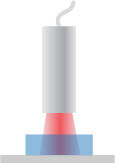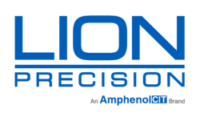Capacitive Sensor Application Note LT03-0015
Copyright © 2014 Lion Precision. www.lionprecision.com
Related Products
Introduction
It’s Complicated. We Can Help.Capacitive sensors are most often used to measure the change in position of a conductive target. But capacitive sensors can be effective in measuring presence, density, thickness, and location of non-conductors as well. The trick is controlling all the other variables that will affect the measurement.
Capacitive Sensor Basics
Capacitive sensors work by measuring the capacitance between the active sensing surface of the capacitive probe and a conductive target. In most applications, the distance between the probe and target changes which creates a change in capacitance which the sensor can interpret as a precise change in distance.
If the distance between the probe and conductive target remains constant, the capacitance can be changed by altering the “dielectric constant” of the material between the probe and the target. The dielectric constant of air is just over 1.00 and is consistent unless humidity gets very high. The dielectric constant of glass, plastic, and film is higher than air. Any such material that passes between the probe and the conductive target will alter the sensor output.
For more detail on the operation of capacitive sensors and dielectric constant, see Capacitive Sensor Operation and Optimization
Measuring Non-Conductors

Non-conductors can be measured by passing the electric field through them to a stationary conductive target behind.
Non-conductive materials like glass and plastic have a different dielectric constant than air. The dielectric constant determines how a non-conductive material affects capacitance between two conductors. When a non-conductor is inserted between the probe and a stationary reference target, the sensing field passes through the material to the grounded target (see figure at right). The presence of the non-conductive material changes the dielectric and therefore changes the capacitance.
Measuring thickness of glass, film, plastic or other nonconductors can be accomplished by setting a capacitive sensor’s probe above a conductive target and adjusting the sensor so it is within its calibrated range. Placing different thicknesses of nonconductive material in the gap will create different sensor outputs. Using a few pieces of known thickness will allow you to determine the amount of change in the sensor output per unit of thickness. This is a process called “mastering.”
Not Just Thickness
Thickness is not the only thing that can change the sensor output. The output of the sensor will change If the density or composition of the material changes or if the dielectric constant is not consistent throughout the material. Essentially, the capacitive sensor system can measure ONE of the following variables only if all the other variables are consistent:
- Thickness
- Dielectric constant
- Material composition
- Density
When one of those variables is of interest, and the others can be controlled (or compensated), a capacitive sensor can provide a measurement solution.
A specific nonconductive application is outlined in our QucikApp Nonconductive Coating on Metal Substrate and is the principle used in our LRD model clear label sensors.
